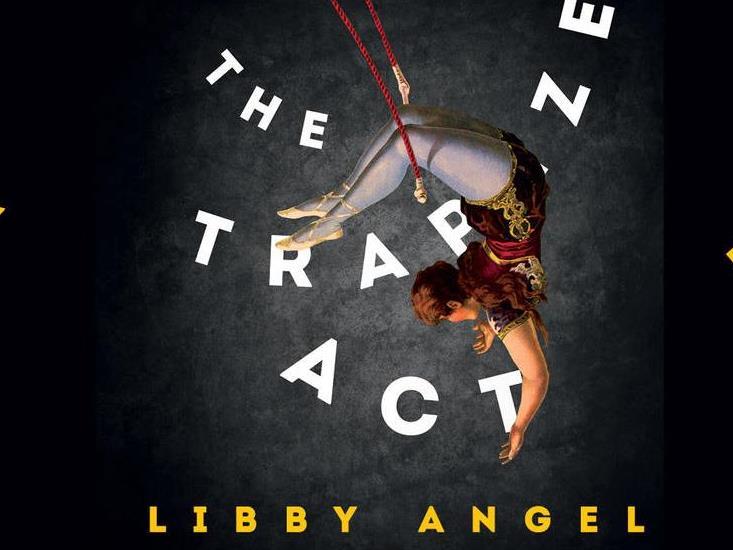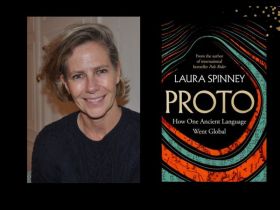’Cover Art: The Trapeze Act written by Libby Angel. Image via text Publishing.
Libby Angel is an Australian poet who has written her first novel The Trapeze Act, and her background as a circus performer is incorporated into the vivid trapeze descriptions. The theme of circus and the history of Rodzirkus with the famed Flying Maartje May propels the start of this novel, but continues only in a metaphoric sense as the family memories about being a trapezist are passed down through to Loretta the narrator who has a sense of destiny about her exotic history, though she ultimately concludes ‘the circus is a collection of fairytales told to frighten children’.
The Trapeze Act is a type of metaphor for family life rather than an imagining of circus history which you may anticipate. Leda (as Loretta’s mother) is the central character, a crazy Dutch lady who ends up in an Australian town – her inheritance of the Rodzirkus circus has dwindled to nothing. It is the 1960s and Leda connects with a criminal law barrister Gilbert and has two children with him. The two children borne of the unlikely pairing of Leda the trapeze artist and Gilbert, the well-known young barrister produce Loretta our almost invisible first person narrator (‘I felt like an imposter on a stage set…’) and Kingston who is a criminal in the making with his excessive boy spirit in blowing things up and various attempts at strangulating Loretta.
The eccentricity of Leda which revolves around spacesuit dressing, inappropriate trapeze acts in public and bad parenting would probably have meant banishment from a conservative Australian town with strict mores from that era, rather than indulgence from her barrister husband. She sits at home being a housewife – actually not even that as they have a housekeeper Mrs Heaven – and doing some community theatre. The author makes claims as to Leda’s outrageousness but perhaps that is more to do with her adventurous circus background. It’s as though Leda has a veneer of ‘crazy actions’ that denote her status rather than the actions ringing true from what her character may do. It results in giving Leda, along with the invisible Loretta, a type of insincerity.
Leda’s view on family can be summarised in this quote from the novel: ‘what was romantic love other than a capitalist unit, a conspiracy designed to ensnare us, a hormonal drive at best?’ and this cynicism pervades this central character so it’s difficult to feel empathy for her. Leda’s tangential relation to life feels like a form of magic realism: the first night she meets Gilbert she watches the glitter from her face whirling down the toilet bowl – ‘the glitter went out to sea, my mother would later recount, where it shimmered on the fishes’ fins’ which doesn’t really match that we are told Leda went out on the town that night without underpants because she was in such a rush to leave the circus.
Interwoven is the story of Loretta’s paternal great-great-great-grandfather’s migration to Australia in search of elephants and ivory, and the unpredictable nature of travelling in the desert. The tendency to jump time periods from the 1960s when the narrator is a child back to 1860s when her ancestors are making the slow boat journey to Australia interspersed with the Dutch circus family history is initially quite frustrating as there are few clues as to whose section of the story we are immersed in. There are transcriptions from diary entries and researched statements about the boat journey to Australia which compose a type of facto-history. These sections certainly highlight Angel’s poetic skills but juxtaposed with the unbelievable character arc of Leda (and Loretta to some degree) are contradictory to the structure of the novel.
There is a lack of cohesive whole to this book with the first section moving between different time periods, the middle chunk being quite engrossing and the ending unsatisfactory, so even though Angel’s poetic influences are clearly foregrounded in the writing: ‘A tableau of kangaroos was arranged on the banks. Even the cockatoos held their din, while the camel stood beside me, awed’, the book did not ring true.
Rating: 3.5
The Trapeze Act
Written by Libby Angel
Published by Text Publishing
Extent: 256pp
Format: Paperback
Text publication date: 3 January 2017
ISBN: 9781925355925
Categories: Historical Fiction
Fiction: Australian





